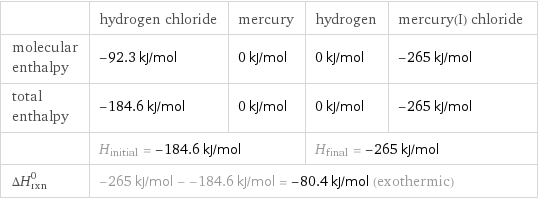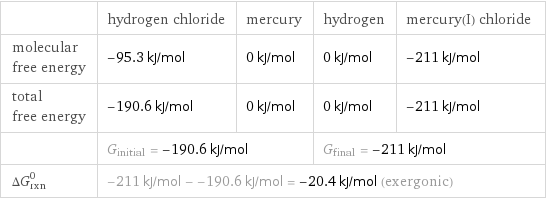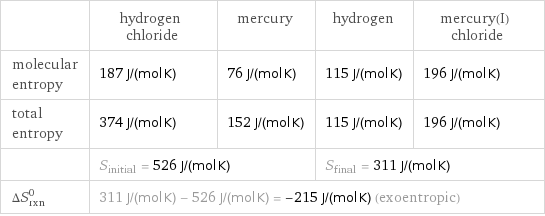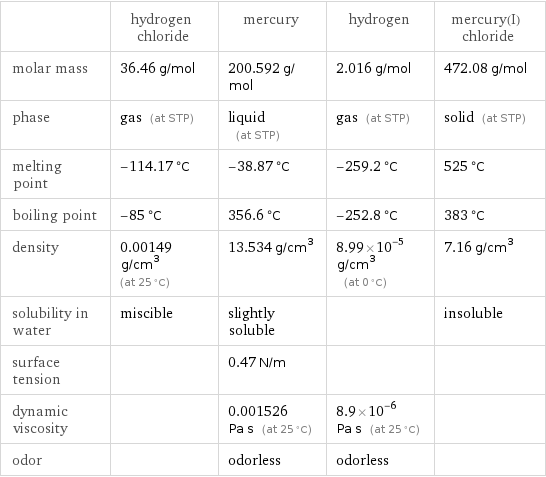Input interpretation

HCl hydrogen chloride + Hg mercury ⟶ H_2 hydrogen + Hg_2Cl_2 mercury(I) chloride
Balanced equation

Balance the chemical equation algebraically: HCl + Hg ⟶ H_2 + Hg_2Cl_2 Add stoichiometric coefficients, c_i, to the reactants and products: c_1 HCl + c_2 Hg ⟶ c_3 H_2 + c_4 Hg_2Cl_2 Set the number of atoms in the reactants equal to the number of atoms in the products for Cl, H and Hg: Cl: | c_1 = 2 c_4 H: | c_1 = 2 c_3 Hg: | c_2 = 2 c_4 Since the coefficients are relative quantities and underdetermined, choose a coefficient to set arbitrarily. To keep the coefficients small, the arbitrary value is ordinarily one. For instance, set c_3 = 1 and solve the system of equations for the remaining coefficients: c_1 = 2 c_2 = 2 c_3 = 1 c_4 = 1 Substitute the coefficients into the chemical reaction to obtain the balanced equation: Answer: | | 2 HCl + 2 Hg ⟶ H_2 + Hg_2Cl_2
Structures

+ ⟶ +
Names

hydrogen chloride + mercury ⟶ hydrogen + mercury(I) chloride
Reaction thermodynamics
Enthalpy

| hydrogen chloride | mercury | hydrogen | mercury(I) chloride molecular enthalpy | -92.3 kJ/mol | 0 kJ/mol | 0 kJ/mol | -265 kJ/mol total enthalpy | -184.6 kJ/mol | 0 kJ/mol | 0 kJ/mol | -265 kJ/mol | H_initial = -184.6 kJ/mol | | H_final = -265 kJ/mol | ΔH_rxn^0 | -265 kJ/mol - -184.6 kJ/mol = -80.4 kJ/mol (exothermic) | | |
Gibbs free energy

| hydrogen chloride | mercury | hydrogen | mercury(I) chloride molecular free energy | -95.3 kJ/mol | 0 kJ/mol | 0 kJ/mol | -211 kJ/mol total free energy | -190.6 kJ/mol | 0 kJ/mol | 0 kJ/mol | -211 kJ/mol | G_initial = -190.6 kJ/mol | | G_final = -211 kJ/mol | ΔG_rxn^0 | -211 kJ/mol - -190.6 kJ/mol = -20.4 kJ/mol (exergonic) | | |
Entropy

| hydrogen chloride | mercury | hydrogen | mercury(I) chloride molecular entropy | 187 J/(mol K) | 76 J/(mol K) | 115 J/(mol K) | 196 J/(mol K) total entropy | 374 J/(mol K) | 152 J/(mol K) | 115 J/(mol K) | 196 J/(mol K) | S_initial = 526 J/(mol K) | | S_final = 311 J/(mol K) | ΔS_rxn^0 | 311 J/(mol K) - 526 J/(mol K) = -215 J/(mol K) (exoentropic) | | |
Equilibrium constant
![Construct the equilibrium constant, K, expression for: HCl + Hg ⟶ H_2 + Hg_2Cl_2 Plan: • Balance the chemical equation. • Determine the stoichiometric numbers. • Assemble the activity expression for each chemical species. • Use the activity expressions to build the equilibrium constant expression. Write the balanced chemical equation: 2 HCl + 2 Hg ⟶ H_2 + Hg_2Cl_2 Assign stoichiometric numbers, ν_i, using the stoichiometric coefficients, c_i, from the balanced chemical equation in the following manner: ν_i = -c_i for reactants and ν_i = c_i for products: chemical species | c_i | ν_i HCl | 2 | -2 Hg | 2 | -2 H_2 | 1 | 1 Hg_2Cl_2 | 1 | 1 Assemble the activity expressions accounting for the state of matter and ν_i: chemical species | c_i | ν_i | activity expression HCl | 2 | -2 | ([HCl])^(-2) Hg | 2 | -2 | ([Hg])^(-2) H_2 | 1 | 1 | [H2] Hg_2Cl_2 | 1 | 1 | [Hg2Cl2] The equilibrium constant symbol in the concentration basis is: K_c Mulitply the activity expressions to arrive at the K_c expression: Answer: | | K_c = ([HCl])^(-2) ([Hg])^(-2) [H2] [Hg2Cl2] = ([H2] [Hg2Cl2])/(([HCl])^2 ([Hg])^2)](../image_source/177f5fd5bf2d25da209f100ba09b1e90.png)
Construct the equilibrium constant, K, expression for: HCl + Hg ⟶ H_2 + Hg_2Cl_2 Plan: • Balance the chemical equation. • Determine the stoichiometric numbers. • Assemble the activity expression for each chemical species. • Use the activity expressions to build the equilibrium constant expression. Write the balanced chemical equation: 2 HCl + 2 Hg ⟶ H_2 + Hg_2Cl_2 Assign stoichiometric numbers, ν_i, using the stoichiometric coefficients, c_i, from the balanced chemical equation in the following manner: ν_i = -c_i for reactants and ν_i = c_i for products: chemical species | c_i | ν_i HCl | 2 | -2 Hg | 2 | -2 H_2 | 1 | 1 Hg_2Cl_2 | 1 | 1 Assemble the activity expressions accounting for the state of matter and ν_i: chemical species | c_i | ν_i | activity expression HCl | 2 | -2 | ([HCl])^(-2) Hg | 2 | -2 | ([Hg])^(-2) H_2 | 1 | 1 | [H2] Hg_2Cl_2 | 1 | 1 | [Hg2Cl2] The equilibrium constant symbol in the concentration basis is: K_c Mulitply the activity expressions to arrive at the K_c expression: Answer: | | K_c = ([HCl])^(-2) ([Hg])^(-2) [H2] [Hg2Cl2] = ([H2] [Hg2Cl2])/(([HCl])^2 ([Hg])^2)
Rate of reaction
![Construct the rate of reaction expression for: HCl + Hg ⟶ H_2 + Hg_2Cl_2 Plan: • Balance the chemical equation. • Determine the stoichiometric numbers. • Assemble the rate term for each chemical species. • Write the rate of reaction expression. Write the balanced chemical equation: 2 HCl + 2 Hg ⟶ H_2 + Hg_2Cl_2 Assign stoichiometric numbers, ν_i, using the stoichiometric coefficients, c_i, from the balanced chemical equation in the following manner: ν_i = -c_i for reactants and ν_i = c_i for products: chemical species | c_i | ν_i HCl | 2 | -2 Hg | 2 | -2 H_2 | 1 | 1 Hg_2Cl_2 | 1 | 1 The rate term for each chemical species, B_i, is 1/ν_i(Δ[B_i])/(Δt) where [B_i] is the amount concentration and t is time: chemical species | c_i | ν_i | rate term HCl | 2 | -2 | -1/2 (Δ[HCl])/(Δt) Hg | 2 | -2 | -1/2 (Δ[Hg])/(Δt) H_2 | 1 | 1 | (Δ[H2])/(Δt) Hg_2Cl_2 | 1 | 1 | (Δ[Hg2Cl2])/(Δt) (for infinitesimal rate of change, replace Δ with d) Set the rate terms equal to each other to arrive at the rate expression: Answer: | | rate = -1/2 (Δ[HCl])/(Δt) = -1/2 (Δ[Hg])/(Δt) = (Δ[H2])/(Δt) = (Δ[Hg2Cl2])/(Δt) (assuming constant volume and no accumulation of intermediates or side products)](../image_source/c9c403e94c0ebfedff905f86a22dcea1.png)
Construct the rate of reaction expression for: HCl + Hg ⟶ H_2 + Hg_2Cl_2 Plan: • Balance the chemical equation. • Determine the stoichiometric numbers. • Assemble the rate term for each chemical species. • Write the rate of reaction expression. Write the balanced chemical equation: 2 HCl + 2 Hg ⟶ H_2 + Hg_2Cl_2 Assign stoichiometric numbers, ν_i, using the stoichiometric coefficients, c_i, from the balanced chemical equation in the following manner: ν_i = -c_i for reactants and ν_i = c_i for products: chemical species | c_i | ν_i HCl | 2 | -2 Hg | 2 | -2 H_2 | 1 | 1 Hg_2Cl_2 | 1 | 1 The rate term for each chemical species, B_i, is 1/ν_i(Δ[B_i])/(Δt) where [B_i] is the amount concentration and t is time: chemical species | c_i | ν_i | rate term HCl | 2 | -2 | -1/2 (Δ[HCl])/(Δt) Hg | 2 | -2 | -1/2 (Δ[Hg])/(Δt) H_2 | 1 | 1 | (Δ[H2])/(Δt) Hg_2Cl_2 | 1 | 1 | (Δ[Hg2Cl2])/(Δt) (for infinitesimal rate of change, replace Δ with d) Set the rate terms equal to each other to arrive at the rate expression: Answer: | | rate = -1/2 (Δ[HCl])/(Δt) = -1/2 (Δ[Hg])/(Δt) = (Δ[H2])/(Δt) = (Δ[Hg2Cl2])/(Δt) (assuming constant volume and no accumulation of intermediates or side products)
Chemical names and formulas

| hydrogen chloride | mercury | hydrogen | mercury(I) chloride formula | HCl | Hg | H_2 | Hg_2Cl_2 Hill formula | ClH | Hg | H_2 | Cl_2Hg_2 name | hydrogen chloride | mercury | hydrogen | mercury(I) chloride IUPAC name | hydrogen chloride | mercury | molecular hydrogen | chloromercury
Substance properties

| hydrogen chloride | mercury | hydrogen | mercury(I) chloride molar mass | 36.46 g/mol | 200.592 g/mol | 2.016 g/mol | 472.08 g/mol phase | gas (at STP) | liquid (at STP) | gas (at STP) | solid (at STP) melting point | -114.17 °C | -38.87 °C | -259.2 °C | 525 °C boiling point | -85 °C | 356.6 °C | -252.8 °C | 383 °C density | 0.00149 g/cm^3 (at 25 °C) | 13.534 g/cm^3 | 8.99×10^-5 g/cm^3 (at 0 °C) | 7.16 g/cm^3 solubility in water | miscible | slightly soluble | | insoluble surface tension | | 0.47 N/m | | dynamic viscosity | | 0.001526 Pa s (at 25 °C) | 8.9×10^-6 Pa s (at 25 °C) | odor | | odorless | odorless |
Units
